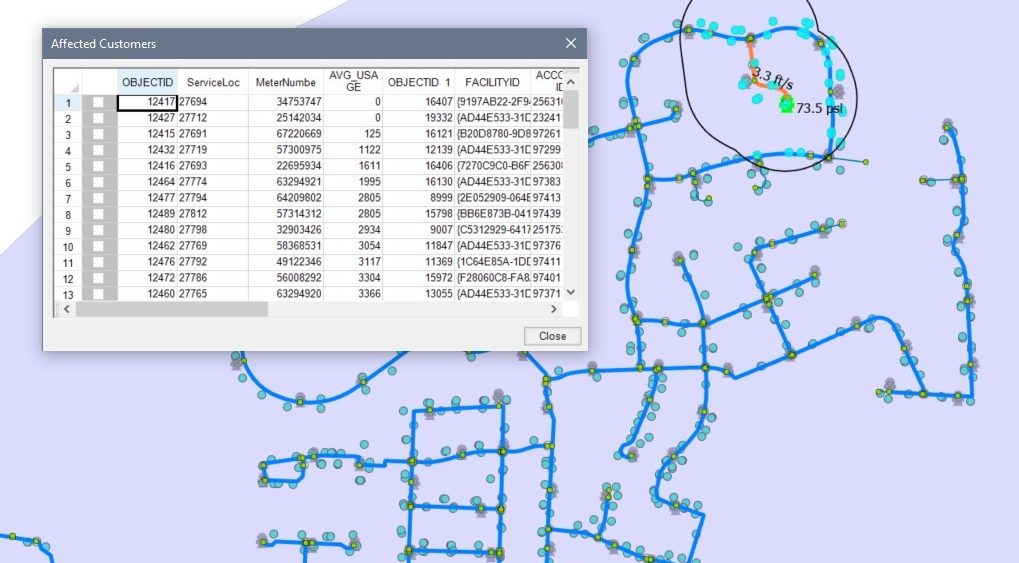
Unidirectional Flushing Modeling
Communities (cities, utilities, authorities, etc.) across the US consistently utilize hydrant flushing methods to clear sediments from their water distribution system. Water system flushing has long been considered an effective method to remove unwanted tastes, odors, or discolorations of the water, and to improve chlorine residuals. When a community considers implementing a flushing plan into their system, there are a couple of options to choose from. The well-known method (and perhaps most common) is traditional flushing. This is where hydrants are opened in selected areas to discharge water until sediment is removed and the water is clear. Though this method is effective, another option proves to be more beneficial. This method is called unidirectional flushing, or simply UDF.
UDF is another method of flushing where valves and hydrants are closed so that scouring velocities remove debris and dirty water from the distribution system. By directing the flow in one direction, and cutting off flows from intersecting pipes, scouring velocities can reach between 5 to 10 feet per second (ft/s). This range of velocity is optimal for removing sediment, biofilm, or tuberculation that can build up over time. UDF technique consists of closing valves and opening hydrant(s) in a sequential manner in a particular section or loop, always starting from a clean water source (storage tank, pump station, previously flushed pipe sections).
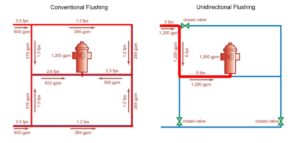
So why choose UDF?
While additional planning and investment is required for a UDF program, the benefits once the program is established are invaluable. The following lists some of the advantages of UDF versus traditional flushing programs:
- Uses up to 40% less water than traditional flushing
- Decreases frequency of flushing due to higher velocities created by closing and opening of valves
- Maintains system pressure above the required minimum pressure of 20 psi
- Creates scouring velocities so that debris is removed from pipes, ultimately improving the capacity of the pipes
- Requires exercising of valves and hydrants which prolongs the life of the valves or locates broken valves or hydrants
What are the steps to creating a UDF program?
The first step to create a successful UDF program begins with the creation and calibration of a hydraulic water model and an assessment of all the system valves and hydrants. The model needs to be prepared and calibrated to simulate the distribution system operations (including storage tanks, pump stations, valves, and pipes). While the model is being created and calibrated, the system valves and hydrants can be checked to confirm if they are operable. Based upon the system valve and hydrant assessment, the water model can be modified to account for valves and hydrants that are marked as inoperable, overall providing a more accurate reflection of the system. UDF is easily done for those communities with existing hydraulic water models.
The next step involves reviewing the model to gain a better understanding of the average daily water flow paths and directions through the system. In a system with multiple pressure zones, tanks, and pump stations, one of the key elements is learning the normal flow direction of water. This step requires recognizing the emptying and filling patterns of the storage tanks, operation of pressure reducing or regulating valves between each pressure zone, and pump station controls throughout the day.
Once familiar with the overall operation of the system, the distribution system must be divided into flushing zones and then into individual sequences. Though sometimes flushing zones can be the already established pressure zones, some cases may require breaking the pressure zones into multiple flushing zones. This is so flushing sequence paths do not overlap and can effectively flush the designated pipes, and not to mention allow a reasonably sized zone for maintenance crews to complete in a timely manner. The following figure is an example of an establish flushing zone (pipes in one zone shown in red).
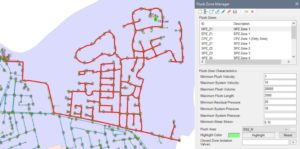
The sequences within each flushing zone start at a clean water source(s) and end at a system hydrant. Each sequence consists of pipe segments (sometimes in a loop), where the size is determined by flushing crew size, duration of flushing, and location of clean water sources. The goal is to flush all sequences in each zone within the flushing crew’s workday. This allows for the reopening of the closed valves that were used to isolate pipe segments during the flushing and avoids having to keep normally open valves closed for extended durations. Once the sequences are established, modeling software can be used to export flushing journals for field crews to utilize when implementing the UDF program. The following figure is an example of a field journal exported from the modeling software.
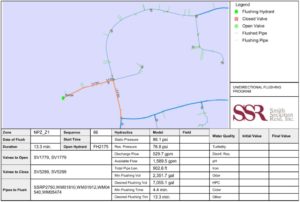
Now is it time to implement the program?
Not so fast! Communication with the public about the UDF program is another key to a successful program. Public outreach is one of the largest efforts to undertake, second to the time and effort spent for the actual flushing. During flushing, there will be unwanted discolorations, tastes, and odors that are stirred up during the cleaning. Anytime a customer sees a discoloration, notices a different taste to their water, or can smell something a little off, they’ll likely be alarmed as to why. This makes communication with the public about the UDF program and flushing schedule crucial, which is in turn a great opportunity for the public to understand their water system better.
However, due to the relatively short duration and constant changing location of the flushing sequences, public outreach can be challenging. Modeling software can output a list and mapping visuals of customers who will be affected when flushing activities take place in the area. This feature is to aid utilities in providing a notification to each customer prior to the flushing activities taking place. The following figure shows the output of the model when identifying which customers will be affected by a specific flushing sequence.
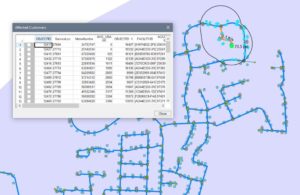
UDF programs are proven to provide many benefits to those communities who implement them. As previously mentioned, UDF programs provide improved cleaning of pipes, less water loss, remove unwanted tastes and odors, and provide an overall improvement in pipe capacity. Implementing a successful UDF program benefits not only the service provider (whether that be cities, utilities, or authorities), but more importantly aids in serving water more efficiently and effectively to the community.
This is a continuation of our series on Water Models, the previous posts focused on Benefits of a Water Model and Water Modeling Analyses.
If you have a specific topic you’d like our team of engineers and experts to cover, email info@ssr-inc.com.








